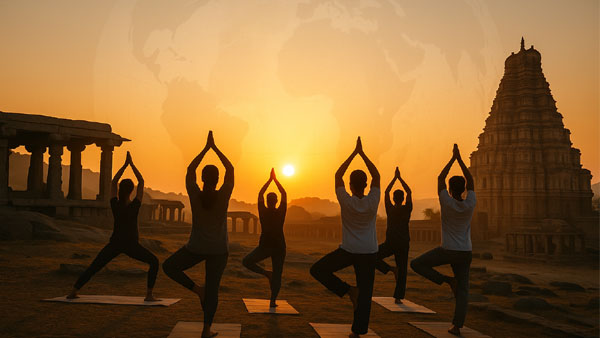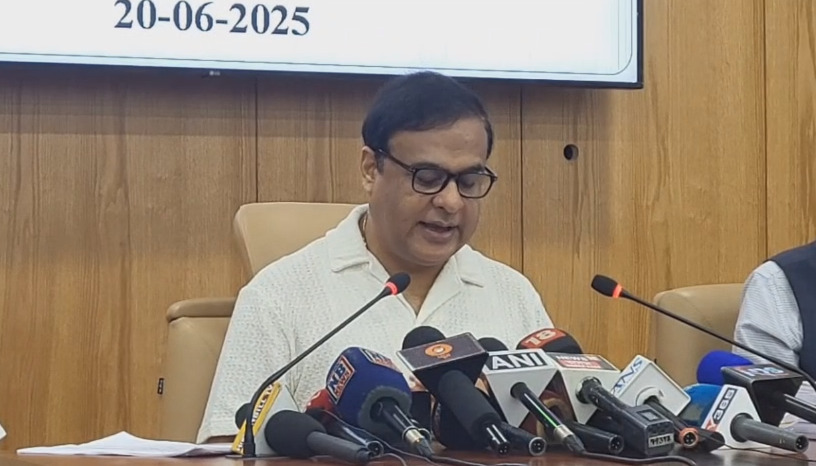By Dipak Kurmi
As dawn breaks across India on June 21, 2025, the quietude of ancient stone and sanctified soil will resound with the rhythmic breath and graceful postures of thousands gathered in communion with nature and self. This year marks the 11th observance of International Yoga Day, a global celebration that intertwines the timeless practice of yoga with humanity’s shared aspiration for harmony. Under the evocative theme Yoga for One Earth, One Health, this sacred occasion beckons individuals to embark on a transformative journey toward holistic well-being, uniting personal vitality with planetary balance. Coinciding with World Music Day, this date weaves a radiant tapestry that transcends cultures, borders, and generations, harmonizing the physical discipline of yoga, rooted in India’s ancient heritage, with the ethereal melodies of music that elevate the human spirit. This divine synergy, celebrated at iconic heritage sites across India, underscores yoga’s enduring capacity to foster inner equilibrium and global unity, illuminating a path to health and transcendence in a world craving connection.
Yoga, a practice spanning over five millennia, finds its origins in the fertile philosophical soil of ancient India. Sacred texts such as the Rigveda, Upanishads, and Bhagavad Gita provide early insights into its foundational principles, emphasizing the harmonious integration of mind, body, and soul. Around 400 CE, the sage Patanjali systematized these teachings in his Yoga Sutras, delineating the eight limbs of yoga—a comprehensive framework encompassing ethical principles, physical postures, breath control, and meditation. Over centuries, yoga evolved through the contributions of diverse cultures and practitioners, giving rise to varied styles such as Hatha, Ashtanga, and Kundalini. Yet, at its core, yoga remains a timeless odyssey of self-discovery, a path toward enlightenment that transcends temporal and geographical boundaries, continually adapting while preserving its essence of inner balance.
This ancient discipline has blossomed into a global phenomenon, embraced by millions for its multifaceted benefits, substantiated by rigorous scientific inquiry. Research published in the European Journal of Preventive Cardiology highlights yoga’s capacity to bolster cardiovascular health, improving blood pressure, cholesterol levels, and body mass index. Similarly, the Journal of Psychiatric Practice underscores yoga’s efficacy in alleviating symptoms of major depressive disorder through a synergy of physical postures, mindfulness, and breath control, fostering mental clarity and emotional resilience. The International Journal of Yoga further illuminates yoga’s role in nurturing emotional regulation, with practices like guided meditation and pranayama empowering individuals to navigate life’s challenges with poise. These findings affirm yoga’s enduring relevance, seamlessly bridging ancient wisdom with modern science to offer a holistic approach to well-being.
The global embrace of yoga is palpable in its widespread adoption. In the United States, participation has surged over the past decade, with millions weaving yoga into their daily lives. Across Europe, yoga has been integrated into public health initiatives and educational curricula, reflecting its recognized value in promoting comprehensive wellness. This universal appeal culminated in the establishment of International Yoga Day, proposed by India’s Prime Minister Narendra Modi during his 2014 address to the United Nations General Assembly. With an unprecedented 177 nations co-sponsoring the resolution, the day underscores yoga’s transformative potential to foster physical, mental, and spiritual health. On June 21, 2025, under the theme Yoga for One Earth, One Health, global events—ranging from mass yoga sessions to workshops and educational initiatives—will celebrate yoga’s capacity to unite humanity in a collective pursuit of harmony and peace, with India leading the charge through a remarkable cultural initiative.
In an unprecedented effort, the Ministry of Culture of India is orchestrating yoga sessions at 100 iconic destinations and 50 additional cultural sites, creating a unique convergence of yoga’s healing power and India’s tangible heritage. These events aim to reaffirm that India’s cultural legacy is not static or archaic—it is a living, breathing continuum that sustains and inspires contemporary wellness. The main national celebration will take place in Visakhapatnam, Andhra Pradesh, where Prime Minister Narendra Modi will lead a mass yoga session, joined by Chief Minister N. Chandrababu Naidu and Deputy Chief Minister Pawan Kalyan. Their presence adds both symbolic and administrative weight to an event that transcends ceremonial functions, serving as a national reminder of yoga’s enduring relevance as both an individual practice and a collective ethos. Reports suggest that this event, dubbed Yogandhra, anticipates participation from approximately 500,000 people, amplifying the scale of this cultural and wellness movement.
A standout feature of International Yoga Day 2025 is the integration of UNESCO World Heritage Sites as venues for yoga sessions, breathing new life into these storied spaces. From the sacred burial mounds of Charaideo Moidam in Assam to the architectural marvels of Rani Ki Vav and Dholavira in Gujarat, the monumental ruins of Hampi and Pattadakal in Karnataka, the spiritually evocative Khajuraho Group of Monuments and Sanchi Stupa in Madhya Pradesh, the Sun Temple at Konark in Odisha, the Elephanta Caves near Mumbai, and the Brihadisvara Temple in Tamil Nadu, these locations embody the philosophy of yoga—unity, balance, and transcendence. By hosting sessions at these sites, India reclaims these spaces from passive tourism, reanimating them with purpose and energy, aligning with the theme Yoga for One Earth, One Health.
Beyond UNESCO sites, a diverse array of historical and cultural landmarks will participate, including Golconda Fort and Salarjung Museum in Hyderabad, Jallianwala Bagh in Amritsar, Chittorgarh and Kumbhalgarh Forts in Rajasthan, and Pari Mahal in Srinagar. The Archaeological Survey of India (ASI) is facilitating sessions at sites under its Chandigarh Circle, such as Bathinda Fort, Shamsher Khan’s Tomb in Batala, Maharaja Ranjit Singh Fort in Phillaur, Jallianwala Bagh, and the Ruined Qila of Prithviraj Chauhan in Hansi, Haryana. Union Minister of Culture and Tourism Gajendra Singh Shekhawat will lead a session at the historic Mehrangarh Fort in Jodhpur, while the Ministry of Tourism will organize a mass yoga event at the Sun Dial Lawns of the Qutub Minar complex in Delhi from 6 to 8 a.m., showcasing yoga as a mass movement transcending age, religion, geography, and class.
The synergy of yoga and music, celebrated concurrently on World Music Day, enhances this global event. Originating in France in the early 1980s, Fête de la Musique invites musicians to fill public spaces with melody, honoring music’s universal language. Scientific studies affirm music’s therapeutic benefits, reducing stress, mitigating pain, and enhancing cognitive performance. When integrated into yoga, music fosters an immersive environment conducive to focus and relaxation, amplifying the practice’s emotional and mental benefits. Sadhguru, the renowned yogi, describes yoga as a process of aligning body and mind with nature and music, a philosophy embodied during the Isha Foundation’s Shivaratri celebrations, where meditative practices and melodies converge to elevate participants into tranquility. B.K.S. Iyengar, a pioneering guru, described yoga as a holistic science encompassing physical, mental, and spiritual evolution, with music serving as a powerful catalyst for mental clarity and emotional balance.
Dr. Pratiksha Gadkari, quoted in a June 21, 2022, Times of India report, emphasizes yoga’s role in enhancing joint flexibility, improving range of motion, and cultivating balance, advocating for soothing music to invigorate practice. Amar Kulkarni, a celebrated singer, highlights the resonance between yoga’s Omkar Sadhana and Indian classical music, where sound vibrations channel potent energy, strengthening respiratory capacity and fostering unity with the Earth. While styles like Vinyasa and Anusara embrace music, Iyengar yoga often prioritizes a minimalistic auditory environment, reflecting the diversity of yoga traditions.
The theme Yoga for One Earth, One Health resonates deeply amid global challenges like climate change and mental health crises. Yoga’s asanas, rooted in nature, and pranayama mirror natural rhythms, promoting ecological humility. As millions gather—from Tokyo to Toronto, Himalayan peaks to desert sands—International Yoga Day 2025 becomes a pilgrimage inward, toward stillness, awareness, and unity. Through yoga, humanity is invited to live lightly, love deeply, and act responsibly, forging a collective journey toward health, peace, and a unified Earth.
(the writer can be reached at dipakkurmiglpltd@gmail.com)




